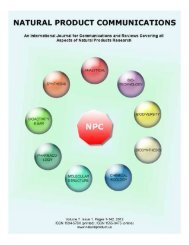This Issue is Dedicated to the Memory of Professor Ivano Morelli
This Issue is Dedicated to the Memory of Professor Ivano Morelli
This Issue is Dedicated to the Memory of Professor Ivano Morelli
Create successful ePaper yourself
Turn your PDF publications into a flip-book with our unique Google optimized e-Paper software.
Triterpenes from Maytenus macrocarpa Natural Product Communications Vol. 1 (12) 2006 1075<br />
allowed us <strong>to</strong> clarify <strong>the</strong> difference between <strong>the</strong> two<br />
compounds. While, in <strong>the</strong> case <strong>of</strong> 3, <strong>the</strong> ROESY<br />
spectrum showed correlations between <strong>the</strong> signal at<br />
δ 1.22 (Me-30) and <strong>the</strong> signals at δ 2.36 (H-18), 3.52<br />
(H-22), and 1.01 (Me-28), <strong>the</strong>se effects were absent<br />
in <strong>the</strong> ROESY spectrum <strong>of</strong> 1, where <strong>the</strong> signal at<br />
δ 1.26 (Me-29) showed a correlation with that at<br />
δ 1.33 (Me-27). <strong>Th<strong>is</strong></strong> evidence led <strong>to</strong> <strong>the</strong> conclusion<br />
that 1 was 3β,22α-dihydroxy-olean-12-en-30-oic<br />
acid, which was named macrocarpoic acid A.<br />
Compound 2 showed, in <strong>the</strong> ESI-MS in positive ion<br />
mode, <strong>the</strong> quasi-molecular ion [M+H] + at m/z 471,<br />
corresponding <strong>to</strong> <strong>the</strong> molecular formula C 30 H 46 O 4 .<br />
The compound exhibited, in its 1 H NMR spectrum,<br />
seven singlet methyl groups (δ 0.95, 1.09, 1.11 x 2,<br />
1.13, 1.26, 1.33), one olefinic pro<strong>to</strong>n (δ 5.25), and<br />
one methine pro<strong>to</strong>n (δ 3.63) linked <strong>to</strong> an oxygen<br />
bearing carbon. In <strong>the</strong> 13 C NMR spectrum <strong>the</strong><br />
occurrence <strong>of</strong> signals for 30 carbons, including peaks<br />
at δ 123.4, 143.5, 181.0 and 219.0, suggested that 2<br />
was an oxoolean-12-enoic acid [13]. By compar<strong>is</strong>on<br />
<strong>of</strong> NMR data <strong>of</strong> 2 with those <strong>of</strong> 1 it was speculated<br />
that <strong>the</strong> position <strong>of</strong> <strong>the</strong> carbonyl group (δ 219.0) was<br />
at C-3 on <strong>the</strong> bas<strong>is</strong> <strong>of</strong> <strong>the</strong> absence in 2 <strong>of</strong> <strong>the</strong> signals<br />
at δ 3.19 in <strong>the</strong> 1 H NMR spectrum and 79.7 in <strong>the</strong><br />
13 C NMR spectrum, observed for 1. It was confirmed<br />
by <strong>the</strong> long range correlations observed in <strong>the</strong> HMBC<br />
spectrum between <strong>the</strong> pro<strong>to</strong>n signals at δ 1.09<br />
(Me-23) and 1.11 (Me-24) and <strong>the</strong> carbon resonance<br />
at δ 219.0 (C-3). Thus 2 was assigned as<br />
22α-hydroxy-olean-12-en-3-oxo-30-oic acid, and<br />
named macrocarpoic acid B.<br />
The molecular formula C 39 H 56 O 4 was assigned <strong>to</strong><br />
compound 7 on <strong>the</strong> bas<strong>is</strong> <strong>of</strong> <strong>the</strong> ESI-MS spectrum,<br />
which showed <strong>the</strong> quasi-molecular ion peak [M+H] +<br />
at m/z 589. The 1 H NMR spectrum showed seven<br />
methyl groups at δ 0.88 (d, J = 6.5 Hz), 0.96 (s), 0.97<br />
(d, J = 6.5 Hz), 1.01 (s), 1.08 (s), 1.09 (s), and 1.17<br />
(s), two signals ascribable <strong>to</strong> a primary alcoholic<br />
function at δ 3.08 and 3.59 (each 1H, d, J = 11.0 Hz),<br />
and a signal for a methine pro<strong>to</strong>n linked <strong>to</strong> an<br />
oxygen-bearing carbon at δ 4.58 (dd, J = 3.5 and 11.0<br />
Hz). Fur<strong>the</strong>r features were signals due <strong>to</strong> three<br />
olefinic pro<strong>to</strong>ns at δ 5.21 (t, J = 3.5), 6.32 (d, J = 15.9<br />
Hz ), and 7.64 (d, J = 15.9 Hz ), and signals at δ 6.83<br />
(2H, d, J = 8.0 Hz) and 7.50 (2H, d, J = 8.0 Hz),<br />
typical <strong>of</strong> a 1,4-d<strong>is</strong>ubstituted aromatic ring. The 13 C<br />
NMR spectroscopic data <strong>of</strong> 7 were similar <strong>to</strong> those <strong>of</strong><br />
urs-12-en-3β,28-diol, known as uvaol [14], except for<br />
<strong>the</strong> chemical shift <strong>of</strong> C-3 and <strong>the</strong> occurrence <strong>of</strong> an<br />
acyl moiety identified as (E)-p-coumaroyl. In <strong>the</strong><br />
HMBC spectrum, <strong>the</strong> pro<strong>to</strong>n at δ 4.58 (H-3)<br />
correlated with <strong>the</strong> carbon resonance at δ 167.2<br />
(C=O), indicating that <strong>the</strong> (E)-coumaroyl group was<br />
located at C-3. Thus compound 7 was identified as<br />
3-(E)-coumaroyluvaol, and named macrocarpol A.<br />
The known compounds maytenfolic acid (3)<br />
[11], trip<strong>to</strong>triterpenonic acid A (4) [15], 22-epimaytenfolic<br />
acid (5) [16], 22-epi-trip<strong>to</strong>triterpenonic<br />
acid A (6) [16], 3-(E)-caffeoyluvaol (8) [14], 3-(E)-pcoumaroylbetulin<br />
(9) [17], 3-(Z)-p-coumaroylbetulin<br />
(10) [18], 3-(E)-caffeoylbetulin (11) [18], nepeticin<br />
(12) [12], and orthosphenic acid (13) [12] were<br />
identified by compar<strong>is</strong>on <strong>of</strong> <strong>the</strong>ir spectroscopic data<br />
with those reported in <strong>the</strong> literature.<br />
The co-occurrence in M. macrocarpa <strong>of</strong> triterpenes<br />
belonging <strong>to</strong> different classes <strong>is</strong> an unusual finding.<br />
For maytenfolic acid (3), previously <strong>is</strong>olated from M.<br />
diversifolia [11], antileukemic activity has been<br />
reported [11], while compounds 9-11, betulin esters,<br />
have been reported <strong>to</strong> exert antitumor promoting<br />
activity [19]. Compounds 7-8 are esters <strong>of</strong> uvaol, for<br />
which antiproliferative and antileukemic activity<br />
have been reported [20].<br />
Table 1: Anti-HIV activity <strong>of</strong> compounds 1-13.<br />
Compounds<br />
1 10 50<br />
2 10 50<br />
3 10 80<br />
4 1 35<br />
5 100 200<br />
6 50 100<br />
7 10 50<br />
8 10 100<br />
9 12 62<br />
10 10 25<br />
11 5 50<br />
12 10 50<br />
13 10 80<br />
a<br />
EC 50 = concentration (μg/mL) that reduced by 50% <strong>the</strong> production <strong>of</strong><br />
b<br />
gp120 in infected C8166 cells. TC 50 = concentration (μg/mL) that caused<br />
50% cy<strong>to</strong><strong>to</strong>xicity <strong>to</strong> uninfected C8166 cells.<br />
EC 50<br />
a<br />
TC 50<br />
b<br />
On <strong>the</strong> bas<strong>is</strong> <strong>of</strong> <strong>the</strong> anti-HIV activity reported for <strong>the</strong><br />
lupane derivative betulinic acid [8-9], and, <strong>to</strong> a minor<br />
extent, for salaspermic acid, a friedelane derivative<br />
closely related <strong>to</strong> orthosphenic acid [10], <strong>the</strong> anti-<br />
HIV activity <strong>of</strong> compounds 1-13 in C8166 cells<br />
infected with HIV-1 MN was tested. The most active<br />
compound was 4, with an EC 50 value <strong>of</strong> 1μg/mL and<br />
a selectivity index above 30 (Table 1). The<br />
investigation <strong>of</strong> <strong>the</strong> mechan<strong>is</strong>m <strong>of</strong> action <strong>of</strong> 4<br />
revealed that it was more effective when added ei<strong>the</strong>r







